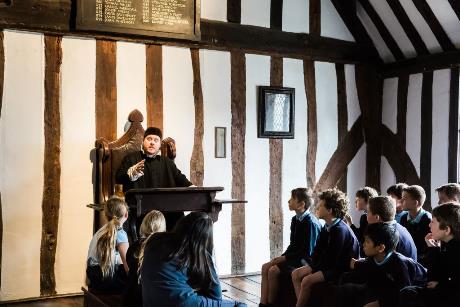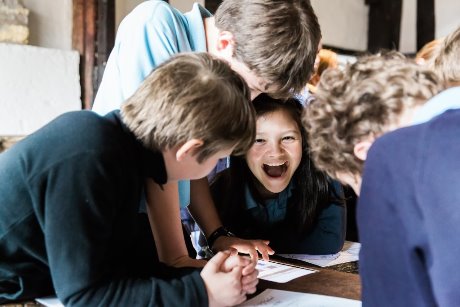
Rachel Bailey took a visit to Shakespeare’s Schoolroom & Guildhall this month. Here, she explains why she thinks it’s a great place for schools to visit.
Following a busy summer, I finally got to visit Shakespeare’s Schoolroom & Guildhall this October. The attraction opened in Stratford-upon-Avon earlier this year – on the 400th anniversary of Shakespeare’s death, in fact – and it’s been on my to-visit list since I first learnt it was opening.
Shakespeare’s Schoolroom & Guildhall is exactly what it says on the tin. It’s the schoolroom in which William Shakespeare received his education, and it’s also the guildhall where he first encountered live theatre. The whole experience is an immersive one.
While the attraction doesn’t have an educational department (yet), there are plenty of opportunities for schools to learn there, in subjects including Maths, Science, Geography, Latin, Art and Design Technology, in addition to the more obvious subjects of English, History and Drama.
I spoke to Sarah Jervis-Hill, marketing and business manager at Shakespeare’s Schoolroom & Guildhall, about the learning opportunities available to visiting school groups.
“We have something to offer all ages, and this is reflected in the school groups that visit us,” Sarah explained. “Shakespeare is such a part of a child’s learning and cultural experience, and schools recognise the value of bringing his legacy to life for pupils through a visit to the place he was once taught.”

Pictured: A school visit to Shakespeare’s Schoolroom. (Photo credit: Sara Beaumont).
A school trip to Shakespeare’s Schoolroom & Guildhall firstly introduces the history of the Guildhall, said to be one of only a handful of surviving Medieval, provincial timber-framed guildhalls in the country.
Pupils can learn about the ways of the Guild of the Holy Cross and civic life in Stratford-upon-Avon in the 16th century, and see a range of Medieval wall paintings – one of which was only discovered during the recent restoration works.
Visitors can then leave the Guildhall to head upstairs to the Schoolroom, where they will be met by a Tudor schoolmaster for an example of a Tudor lesson.
“For both our visiting schools and attraction visitors the most popular aspect of their trip is the lesson that they get to experience with our Tudor schoolmaster,” said Sarah.
“This takes place in the very room that Shakespeare would have had his own lessons and the room is presented just as it would have been; the master looks down from his imposing chair to the pupils who are sat on wooden form benches.”
During my own visit I got to take part in a condensed version of one of these Tudor lessons. As luck would have it, the actor playing the schoolmaster picked on me, and I had to stand and re-enact a scene from Shakespeare’s Julius Caesar – in Latin.
I don’t speak any Latin, and so was considered a bad student and sent back to my wooden bench, perhaps in a spot where Shakespeare himself may have sat all those years ago.

Pictured: Learning in a Tudor-style lesson. (Photo credit: Sara Beaumont).
The interactive nature of a visit should have real appeal to teachers and will put History and English into a whole new perspective for the pupils taking part. Students will get to experience what it was like for William Shakespeare at school in the 1570s. Tudor dress up and games are available, as well as activities such as writing with quills.
I asked Sarah about resources for teachers.
“We are about to launch our Shakespeare’s Schoolroom & Guildhall Teachers Toolkit,” she explained. “This is a resource pack for Key Stage 2 and 3 teachers and pupils which will be online at www.ShakespearesSchoolroom.org by the end of October.
“We have worked with a group of local school teachers on the content of the pack and used the history of Shakespeare’s Schoolroom & Guildhall and its most famous scholar, William Shakespeare, as inspiration.”
This toolkit covers all the subjects mentioned, from English to Maths, and can be used to support follow-up sessions on return to the classroom.

Pictured: Discovering Shakespeare and his work. (Photo credit: Sara Beaumont).
Plans for the future
A Willingly to School programme, which has been developed in conjunction with the Shakespeare Birthplace Trust, is something that’s currently available to local schools. It’s expected to be rolled out to a wider geographic area in the future.
This particular programme comprises a daylong visit for Year 4 and 5 pupils (Key Stage 2), during which the pupils dress in Tudor costume and experience life as a pupil from the Tudor period.
The day includes a two hour lesson in Shakespeare’s Schoolroom & Guildhall with a Tudor Master, followed by visits to other Stratford heritage sites.
For further information teachers should visit www.shakespearesschoolroom.org.










